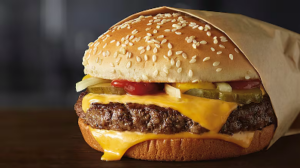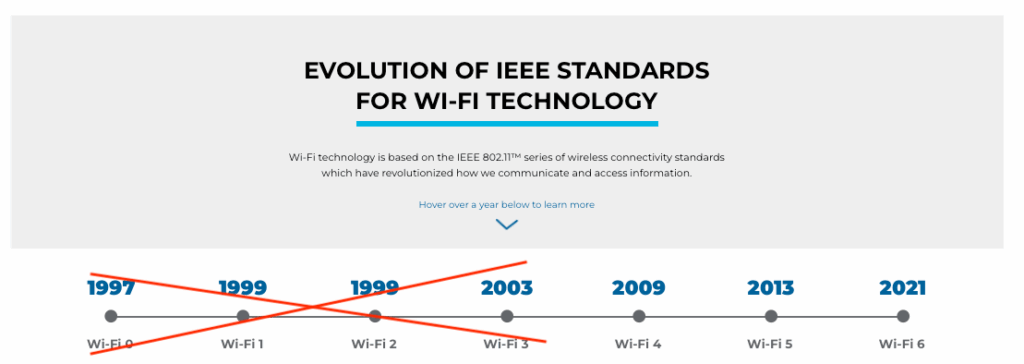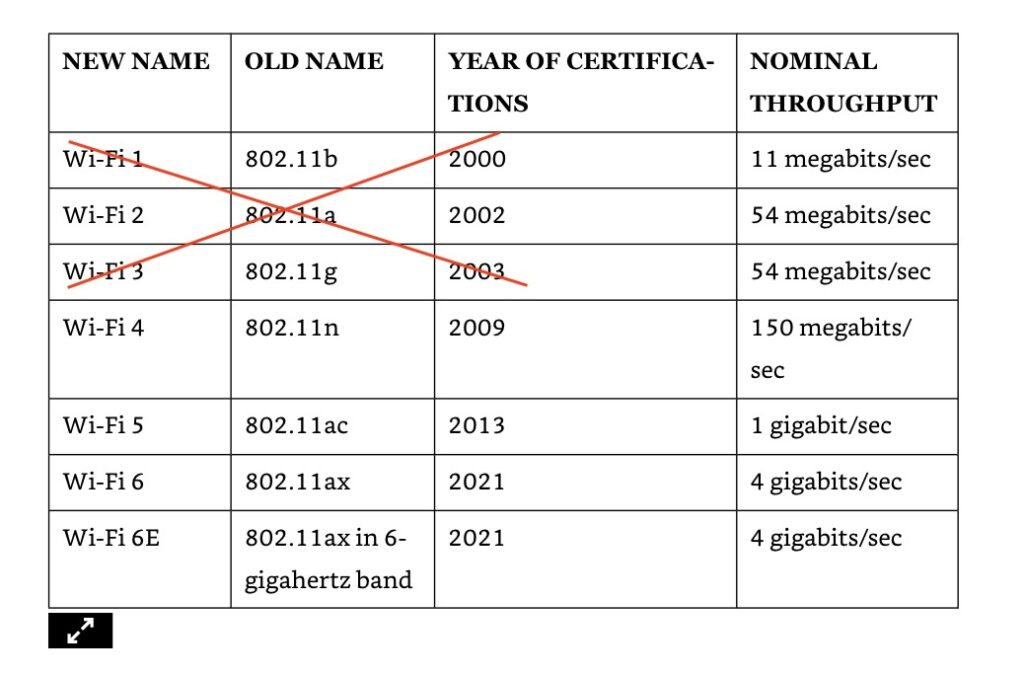Wi-Fi Generation Naming
It’s worth addressing a growing trend where people, organizations, and manufacturers are misaligning IEEE Wireless LAN Standards (802.11) with Wi-Fi generation numbers. While this may stem from a noble intention to clarify the naming convention, it ultimately causes widespread confusion. By accurately mapping these standards to their corresponding Wi-Fi generations, we can foster better understanding and communication about Wi-Fi technology and its capabilities. By striving for precision in our terminology, we can empower users and enhance their comprehension of this vital technology.
The Wi-Fi Alliance (WFA) has the following goals when creating generational Wi-Fi:
- Increase end-user recognition of Wi-Fi technology advancements
- Differentiate and easily identify Wi-Fi technologies contained in devices and network connections
- Increase user adoption of newer Wi-Fi technologies that deliver a better experience
I believe that Wi-Fi generations emerged as a marketing strategy by the WFA to counter 3GPP’s campaign portraying 5G as a Wi-Fi killer.
At the heart of this issue lies a crucial misunderstanding regarding Wi-Fi generation numbering. The WFA, the authoritative body that established the Wi-Fi generation numbering system, clearly states that generation numbers before four should NOT be utilized. It’s imperative to note that there are NO certified products labeled as Wi-Fi 1, Wi-Fi 2, or Wi-Fi 3.
If you doubt the significance of focusing on generation numbers, consider the compelling case of A&W’s 1/3-pound burger marketing misstep. Back in the 1980s, A&W boldly launched a campaign to introduce a 1/3-pound burger, aiming to outshine McDonald’s immensely popular quarter-pounder. Logically, A&W’s offering was larger, more flavourful, and priced even lower than its competitor. Yet, it suffered a spectacular failure in the market.
The critical insight from market research revealed a shocking truth: consumers mistakenly believed that because the number “4” is greater than “3,” the McDonald’s 1/4-pound burger was larger, despite the reality of fraction sizes. This fundamental misunderstanding of basic fractions led to the collapse of A&W’s marketing strategy.
This example powerfully illustrates the importance of clear communication regarding generation numbers. If a simple arithmetic misunderstanding can derail an otherwise superior product, imagine the potential pitfalls in more complex branding strategies!

Using these terms misleads consumers and creates significant barriers to finding and purchasing legitimate Wi-Fi products. To protect consumer interests and promote clarity in the marketplace, abandoning these unsanctioned terms and embracing the official Wi-Fi generation designations is essential. Let’s work together to ensure consumers are accurately informed and empowered in purchasing decisions.
In April 2023, the WFA published a guideline outlining how to use generation numbers now and in the future:
- Generations of Wi-Fi prior to Wi-Fi 4 will not be assigned names.
- If a company adopts Wi-Fi generation names, the following guidelines shall be followed:
- The format of generation names is simply “Wi-Fi” followed by a whole number. (Although, I’m not sure how to explain what happened with “Wi-Fi 6E”)
- Generation names shall not contain additional text or description.
- Generation names shall not have versions identified.
For example, Wi-Fi 5.1, Wi-Fi Version 5.2, or Advanced Wi-Fi 5 shall not be used. (This does not explain what happened with “Wi-Fi 6r2”)
- Generation names shall only be used as a text reference.
- Generation names shall not be incorporated into any logo design.
- Wi-Fi generation names shall both refer to the most advanced technology available in the hardware.
- If technology representing more than one generation exists in a device, the device shall be identified as the most advanced technology it contains.
For example, if the device contains 802.11n 2.4 GHz and 802.11ac 5 GHz technology, it shall be referred to as Wi-Fi 5.
- Use generation names for product packaging, collateral, media, and analysis.
Many recognize the generations as unofficial yet still incorporate them into tables, often marked with an asterisk or highlighted in greyed-out text. However, this approach overlooks a critical understanding: the WFA had valid reasons for disregarding these earlier generations. Appreciating the context behind their decisions is essential to fully grasp the evolution of Wi-Fi generation names.

The generation number for 802.11Prime (the original 802.11 standard from 1997) is a murky choice, which quickly becomes complicated because there are more amendments, bands, and modulation types than we conveniently have room for. 802.11 Prime is sometimes mapped to Wi-Fi 0 and other times to Wi-Fi 1. At least four other amendments should be considered before Wi-Fi 4 (802.11n).
802.11b, often called Wi-Fi 1, represents a significant advancement in wireless networking technology. Expanding the original standard to include two additional data rates—5.5 Mbps and 11 Mbps—802.11b enhanced performance and maintained backward compatibility, allowing users to seamlessly connect to older devices. Operating on the 2.4 GHz band, 802.11b laid the foundation for widespread wireless access.
The reality is that the working group behind 802.11b launched after 802.11a, showcasing the dynamic progress in wireless technology during that era. This context emphasizes the innovative strides made with 802.11b, solidifying its role as a cornerstone in the evolution of Wi-Fi standards.
But here’s the non-obvious part: 802.11b precedes 802.11a, which might confuse those considering alphabetical order or development timelines.
802.11a was pivotal for Wi-Fi standards, expanding into the 5GHz band and introducing OFDM into Wi-Fi. Alphabetically, it precedes 802.11b; should it not be represented with an earlier generation number? To further confuse the matter, some charts map 802.11a to Wi-Fi 2 while other tables map 802.11a to Wi-Fi 3.
We now face the challenge of identifying a generation number for 802.11g. If we start with generation 0, we see that 11g conveniently aligns with generation 3 (side note: this is reason number 10, that I believe parents should teach their kids to start counting at 0). However, the dilemma arises with using “Wi-Fi 3”, since Edgewater Wireless long ago claimed the trademark for WiFi3™ for its proprietary ultrawideband, multi-channel wireless technology. This challenge likely led the WFA to step back from using generation numbers lower than 4.
Another thing to consider is that approximately every four years, the IEEE consolidates amendments into an updated revision of the 802.11 standard. This has been evident in the release of 802.11-2012, 802.11-2016, 802.11-2020, and the soon-to-be-released 802.11-2024 version. Once these consolidations are issued, the amendments are incorporated as clauses or added details spread across existing clauses. At this point, the original amendments no longer exist and are deprecated.
Many prefer referencing clause numbers that typically align with specific amendments to navigate this issue. However, it’s crucial to recognize the potential pitfalls of this method: clause numbers, which function like chapter numbers, can change from one roll-up to another, leading to inconsistencies and potential confusion. Therefore, when discussing clauses, it’s vital to specify whether you’re referring to clause 17 in the 2012 or 2016 roll-up. This clarity enhances understanding and ensures that everyone is on the same page, fostering effective communication and collaboration.
| Wi-Fi Generation Number | Band (GHz) | IEEE 802.11 Amendment | Abbreviation | 802.11-2012 Clause | 802.11-2016 Clause | 802.11-2020 Clause |
|---|---|---|---|---|---|---|
| – | 2.4 | “Prime” | DSSS | 16 | 15 | 15 |
| – | 2.4 | 11b | HR/DSSS | 17 | 16 | 16 |
| – | 5 | 11a | OFDM | 18 | 17 | 17 |
| – | 2.4 | 11g | ERP | 19 | 18 | 18 |
| Wi-Fi 4 | 2.4/5 | 11n | HT | 20 | 19 | 19 |
| – | 3.6 | 11y | ||||
| Wi-Fi 5 | 5 | 11ac | VHT | 21 | 21 | |
| – | 60 | 11ad | VHT in 60 GHz | |||
| – | <1 | 11ah | S1G | 23 | ||
| Wi-Fi 6 | 2.4/5 | 11ax | HE | |||
| Wi-Fi 6E | 6 | 11ax | HE | |||
| Wi-Fi 6r2 | 2.4/5 | 11ax | HE | |||
| Wi-Fi 7 | 2.4/5/6 | 11be | EHT | |||
| Wi-Fi 8 | 2.4/5/6 | 11bn | UHR |
Update (4/5/2025): To add to this, Fugazi, the IEEE erroneously refers to generations 1-3 as shown below.

I recently read “Beyond Everywhere: How Wi-Fi Became the World’s Most Beloved Technology” by Greg Ennis. I must admit I thought the book was incredibly insightful into the history of Wi-Fi evolution from the eyes of someone who was there from the beginning. I was with Greg until chapter 34, which included a table listing Wi-Fi generations 1-3. This was heart-crushing, especially as the book was written by a technical expert championing the WFA, which explicitly disallows use of Wi-Fi generation numbers before Wi-Fi 4.

Slàinte!
Resources
Wi-Fi® Alliance Brand Style Guide
https://www.wi-fi.org/system/files/Wi-Fi_Alliance_Brand_Style_Guide_202306.pdf
Wi-Fi Alliance Generation Wi-Fi® User Guide (April 2023)
https://www.wi-fi.org/system/files/Generational_Wi-Fi_User_Guide_202304.pdf
IEEE 802.11-2020 (superseded by IEEE 802.11-2024)
https://standards.ieee.org/ieee/802.11/7028
IEEE 802.11-2024 (active standard)
https://standards.ieee.org/ieee/802.11/10548
Wi-Fi Certified 6
https://www.wi-fi.org/discover-wi-fi/wi-fi-certified-6
Wi-Fi 6E certification – see Wi-Fi Certified 6
Wi-Fi 6 Release 2
https://www.wi-fi.org/beacon/saju-palayur/wi-fi-certified-6-release-2-better-wireless-for-iot
Wi-Fi Certified 7
https://www.wi-fi.org/discover-wi-fi/wi-fi-certified-7
Canadian Wi-Fi & Design Trademark for “Wi-Fi”
https://ised-isde.canada.ca/cipo/trademark-search/1072831?lang=eng
Edgewater Wireless Introduces New Generation of High-Performance WiFi3TM
A&W 1/3-pound burger campaign fails
“Beyond Everywhere: How Wi-Fi Became the World’s Most Beloved Technology” by Greg Ennis